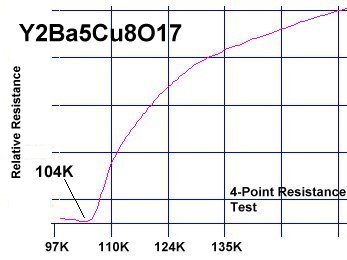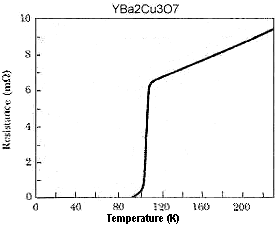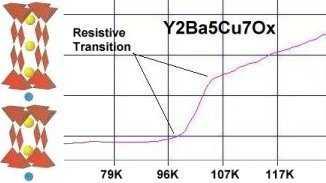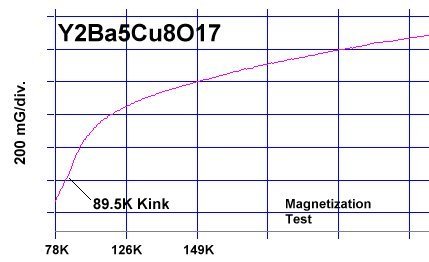
 A New 104K YBCO Variant
A New 104K YBCO Variantwith an Unusual Transition Curve

 A New 104K YBCO Variant
A New 104K YBCO Variant
Superconductors.ORG herein reports the discovery of a new YBCO variant with resistive Tc near 104 Kelvin and a most unusual transition curve. The compound has the formula Y2Ba5Cu8O17 or "Y258". No new elements were added to the original YBCO mix.
The above left plot[1] shows a resistance-v-temperature graph of the new material alongside a plot of standard YBCO. Its transition to a superconductive state has a very gradual resistance drop when compared to legacy YBCO.
 |
Unlike standard YBCO and Y358, the structure of Y258 is not collinear along the C axis. Shown at left, it is an intergrowth of 3212C and 2212C structures, with branching of the CuO2 chains in the 2212C sub-structure. It can be most easily characterized as a "247" with one extra barium atom and one extra copper atom. Below is a plot of Y257, which was the prototype for this discovery. Its response curve is conventional, but with a lower Tc near 96K. 
|
The magnetization curve of Y258 is also unusual. In most conventional superconductors, a diamagnetic component suddenly appears near the resistive Tc. In this discovery there is a gradual decrease in magnetism and a small kink in the curve near 89.5 Kelvin. That temperature is significant in that it's also the magnetic Tc of Y358 and its calcium-doped analog Y2CaBa4Cu7O16+. Those two superconductors were also enhanced versions of YBCO whose Tc improvements were resistive only. Thus, this kink may represent a Y358 minority phase. Click HERE to read more about this odd behavior.

Synthesis of this material was by the solid state reaction method. Stoichiometric amounts of the below precursors were mixed, pelletized at 70,000 psi and sintered for 12 hours at 890C. The pellet was then annealed for 10+ hours at 500C in flowing O2.
The 4-point probe was bonded to the pellet with CW2400 silver epoxy and used 7 volts on the primary side. Temperature was determined using an Omega type "T" thermocouple and precision OP77 DC amplifier. The magnetometer employed twin Honeywell SS94A1F Hall-effect sensors with a tandem sensitivity of 50 mv/Gauss.
 BACK to "News" page at Superconductors.ORG
BACK to "News" page at Superconductors.ORG